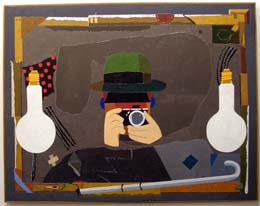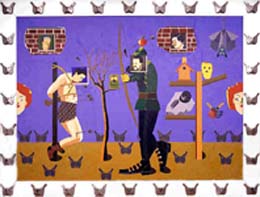Pop Art: Eduardo Arroyo
Eduardo Arroyo is one of the most important living figurative pop art painters hailing from Spain in the XX century, although he has spent most of his life and career in France, more specifically in Paris, where he moved in the mid-fifties to free himself from the oppressive atmosphere created in Spain for socially and politically critical and revolutionary arts and artists by the dictatorship leaded by Franco (do not forget that at the outbreak of the Spanish Civil War, one of the first actions of the fascist troops was assassinating the poet Federico García Lorca). There, he was able to put into practice all the provocative elements of his creative impulse.
Eduardo Arroyo (1937-)

Arroyo was born in Madrid in 1937, although his ancestors hail from the northern province of León. After he studied journalism in Madrid, he moved to Paris, running away to pursue his first artistic attempts as a cartoonist and illustrator, as well as his other passion, writing, which has been his lifelong dedication together with painting. Already in 1960, he could make a living as a painter, despite his reluctance to agree to any form of dictatorial imposition, both politically or artistically, which made him turn into a sort of outsider in the art world. This is visible by the fact that he chose to go into figurative painting in a time when all the painters in Paris were obsessed with abstract art, and also the election of the different themes and topics for his work were not the most fashionable at his time (caustic portraits of Philip II, obscure ballerinas and blood-stained bullfighters).
Around 1960, Eduardo Arroyo took part in his first collective exhibition in Paris, although his rise to prominence didn’t happen until three years later, when he presented a series of portraits of dictators for a Biannual exhibition in Paris, which caused a lot of controversy and even provoked the Spanish government to complain about it. In that same year he organised an individual exhibition in Madrid, but couldn’t be present for its opening because the police was after him and he was forced to flee the country. This exhibition was censored and closed a few days after its opening by the dictatorship.
Eduardo Arroyo demystifies the great masters and at the same time praises the role of the artistic market as the real protector of the art and the artists over museums and public funding for the arts. He also ridicules and “reinterprets” the Spanish topics and common symbols. For this reason he was re-expelled from Spain in 1974, but he got back his Spanish passport in 1976, after the dictator’s death and the end of the fascist regime. But this didn’t turn into direct appreciation for Arroyo’s work, for it took another bunch of years for him to receive the Spanish National Fine Arts Prize in 1982 as a form of restoration for all the way he had been treated during the dictatorship. That same year he had a retrospective exhibition organised at the Pompidou centre in Paris to commemorate his trajectory and as a claim for his artistic status to be rehabilitated.

He has also worked as a scenographer and set designer for the theatre and the movies, being his first work in the field the stage decoration for the movie director Klaus Grüber’s adaptation of Calderón de la Barca’s theatre play “Life is a Dream”. He has made his way into sculpture and works as an illustrator for books as well, both with great critical acclaim and success amongst the public. One of his recurrent themes is the mix of movies and Marxism, two of his greatest obsessions.
His work can be admired today at the Reina Sofia Museum in Madrid, and also at the Fine Arts Museum of Bilbao, where a retrospective exhibition of his painting was recently organised. These are just a few of the milestones in this great artist’s career, for his trajectory is full of awards and recognition.
Since Eduardo Arroyo is still alive, we can expect more of his works and that they will generate a general controversy, both in the art world and the society as a whole, for this unquiet Spanish artist is one of those snipers that never miss the target!
